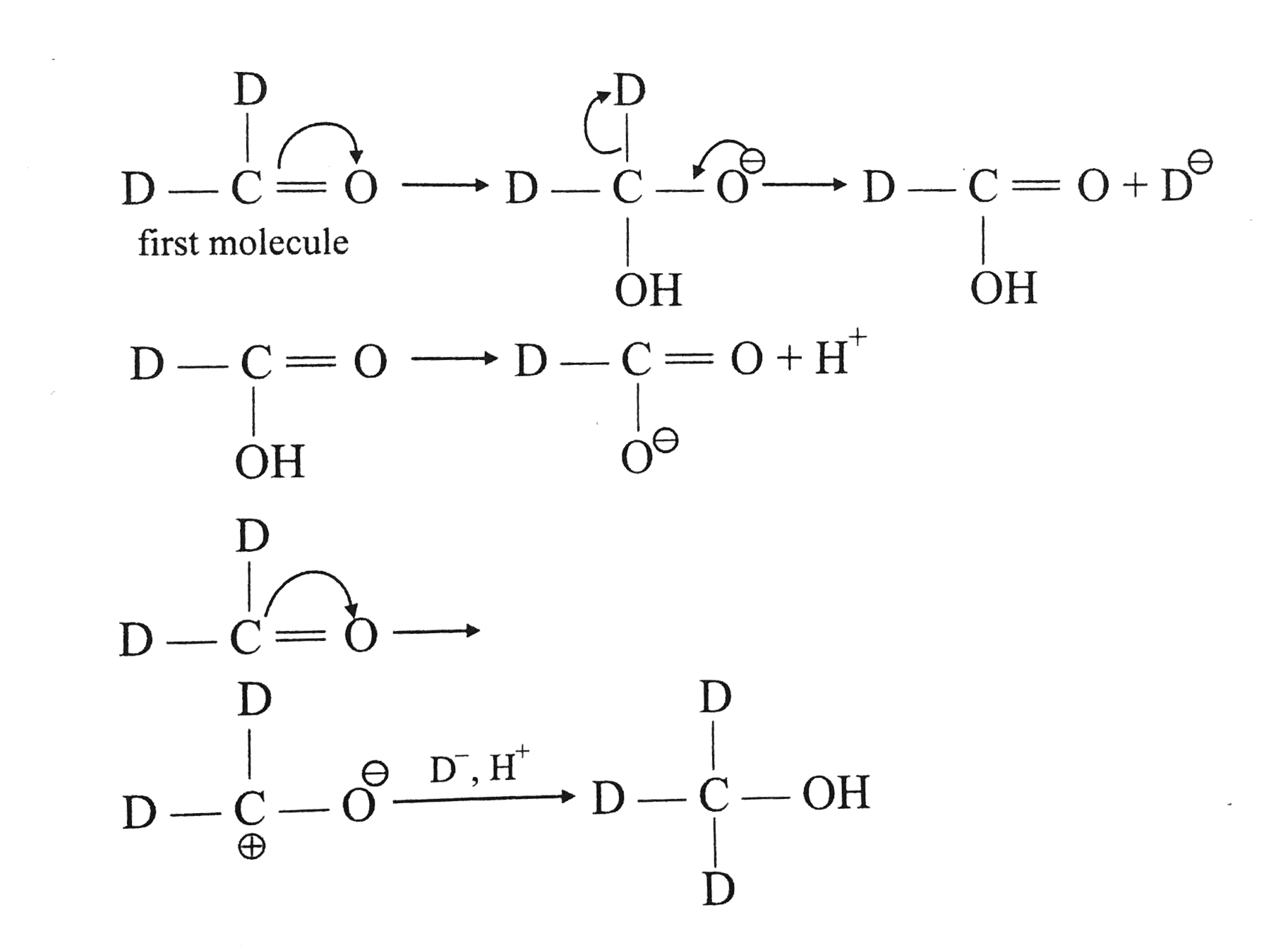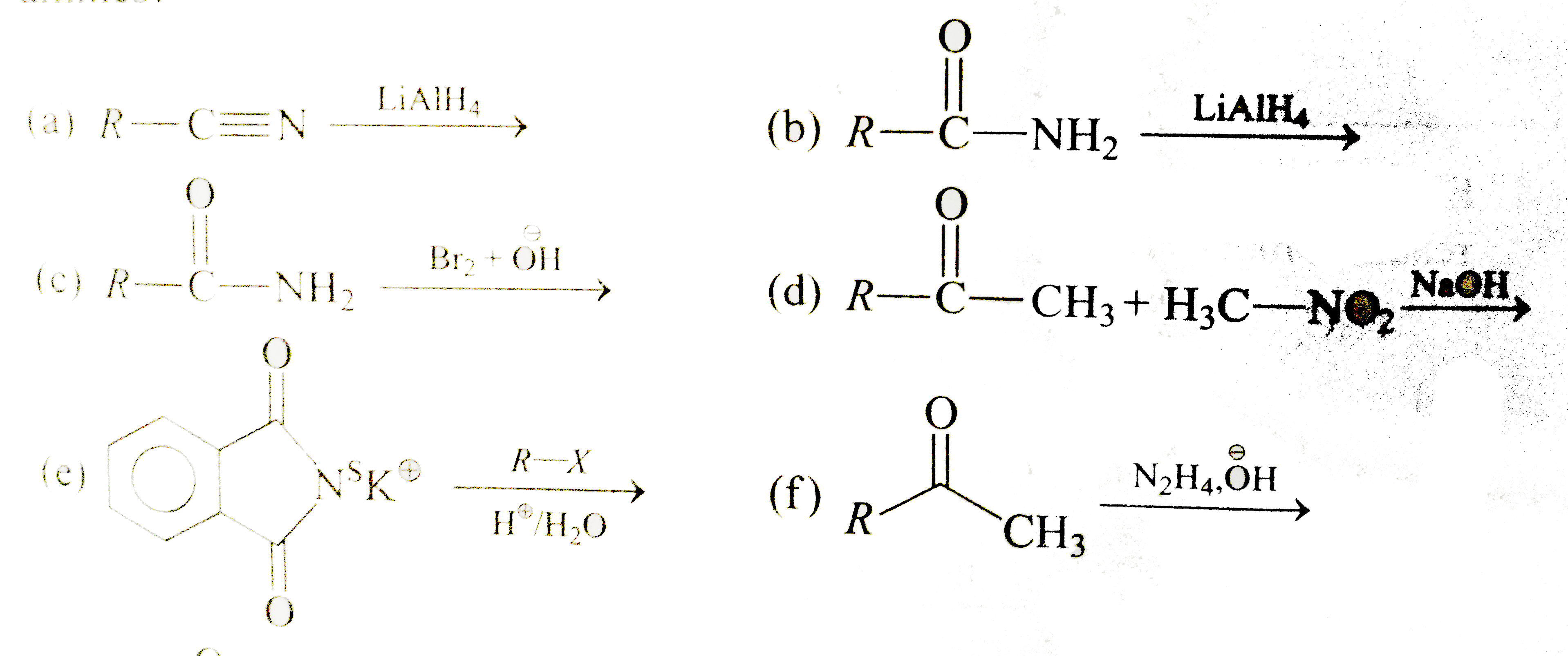2D−D∣∣C=O+OH−Cannizzaro−−−−−−→ (Y is alcohol, D is deuterium)
D−O∣∣C−O−,D−D∣C∣D−OH
D−O∣∣C−O−,D−D∣C∣H−OH
H−O∣∣C−O−,D−D∣C∣D−OH
None of the above is correct
The correct Answer is:a

Thus, products are D−C∣OΘ=O and CD3OH
Topper's Solved these Questions
- BOOK - A2ZCHAPTER - MOCK TESTEXERCISE - Single correct Answer type question40videos
MOCK TEST
- BOOK - A2ZCHAPTER - MOCK TESTEXERCISE - Assertion-Reasoning5videos
MOCK TEST
- BOOK - A2ZCHAPTER - GENERAL PRINCIPLES AND PROCESS OF ISOLATION OF METALSEXERCISE - Section D - Chapter End Test30videos
GENERAL PRINCIPLES AND PROCESS OF ISOLATION OF METALS
- BOOK - A2ZCHAPTER - ORGANIC COMPOUNDS CONTAINING HALOGENSEXERCISE - Section D - Chapter End Test30videos
ORGANIC COMPOUNDS CONTAINING HALOGENS
Similar Questions
Of the following reactions, how many reaction, are used for the preparation of amines?
(a) R−C≡NLiAIh4−−−→ (b) R−O∣∣C−NH2LiAIH4−−−−→
(c) R−O∣C−NH2Br2+ΘOH−−−−−→ (d) R−O∣∣C−CH3+H3C−NO2NaOH−−−→

(g) R−O∣∣C−NH2P2O5−−→D (h) R−CH2−NO2H2,Ni−−−→View SolutionPh−O∣∣C−OH14NaHCO3−−−−−→(A) gas , Ph−OHNa−−→(B) gas
Sum of molecular mass of gas (A+B=?)View Solution
Knowledge Check
- Question 1 - Select One
D−O∣∣C−D50%KOH−−−−−→ order of the reaction is :
A2B3C4D1 - Question 2 - Select One or More
Ph−CH2−O−O||C−CH3+Θ18OH→X+Y:
AX isPh−CH2−18OHBX is Ph−CH2−OHCY is CH3−C||O−OΘDY is CH3−C||O−18OΘ - Question 3 - Select One
Identify the following disproportionation reaction.
I. 2H−D∣C=O+ΘOH→Acid salt (A) + alcohol (B)
II. 2D−D∣C=O+ΘOH→Acid salt(C)+alcohol (D)A(A)(B)(C)(D)D−O∣∣C−OΘCH2DOHD−O∣∣C−OΘCH2DOHB(A)(B)(C)(D)H−O∣∣C−OΘCH3OHH−O∣∣C−OΘCH2DOHC(A)(B)(C)(D)H−O∣∣C−OΘCH2DOHD−O∣∣C−OΘCH2DOHD(A)(B)(C)(D)D−O∣∣C−OΘCH2DOHD−O∣∣C−OΘCD3OH

(i) O3(2)Zn∣H2O−−−−−−−−−−−→(A)+(B)Cannizzaro Reaction−−−−−−−−−−−→(C)+(D) (alcohol)
Identify at the possible productView SolutionCH3−O∣∣C−OHCaO−−−−−→Δ(A) KOH−−−−−→Δ
(B) D2/DO⊕−−−−−−−−−−−−−−→(Prolonged treatment) (C )
How many hydrogen is replaced by DeuteriumView SolutionH2O18+Na→(A)(base)+(B)
CH3−O∣∣C−O−CH2−CH3+(A)→(C)+(D) alcohol
Product (C) of the reaction is :View SolutionHOCH2CH2CH2−O∣∣C−OCH2CH3PCC−−→(A)H2C=CHMgBr−−−−−−−−−−−−−→(1molar equivalent)(B)NH4Cl/H2O−−−−−−−→(C)KOH−−−−−→H2OH3O⊕−−−→⎛⎜ ⎜ ⎜⎝CH3−O∣∣C⎞⎟ ⎟ ⎟⎠2O−−−−−−−−−−−−→Pyridine(D)
Product (D) is :View SolutionH3C−Ch2−O∣∣C−Ch3ΘOD/D2O−−−−−→ Final product is :
View Solution

